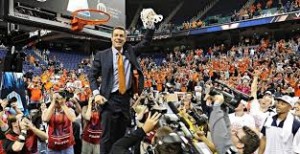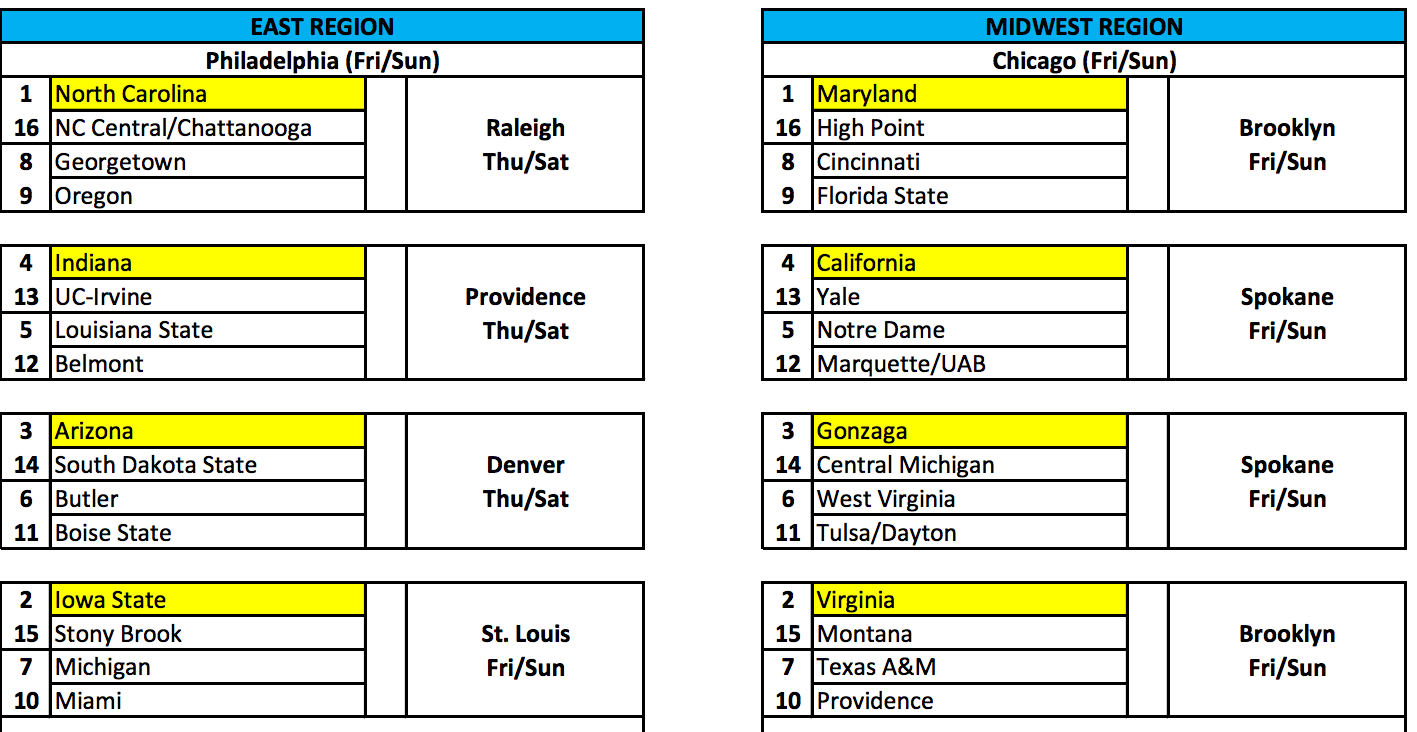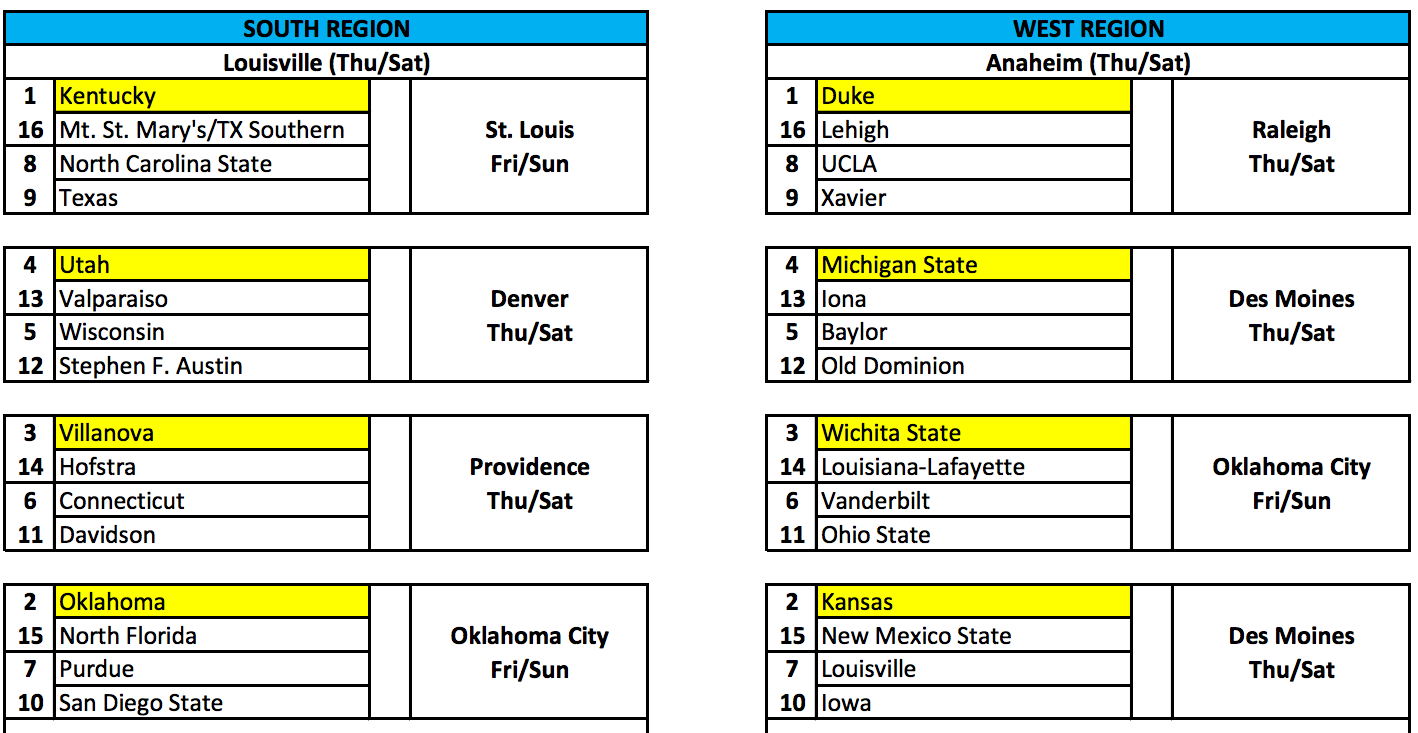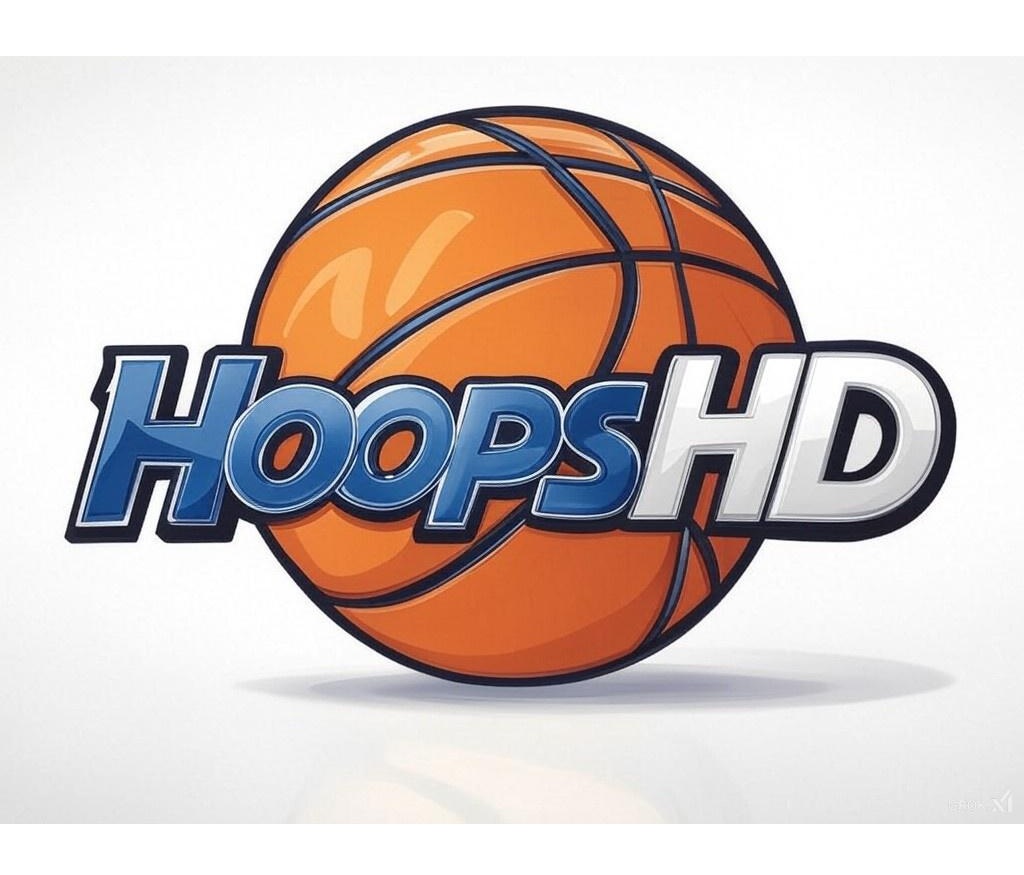For the rest of our extensive Preseason Coverage – CLICK HERE
Tony Bennett is such an amazing coach that he has been named national COY at 2 different schools (Washington State and Virginia)! He is even getting better with age, and his past 2 years with the Cavaliers have featured back-to-back 30-win seasons, a pair of ACC regular season titles, and the program’s highest ranking in more than 3 decades. He is 1 of only 15 D-1 coaches who took less than 9 seasons to win 200 games, and the only current D-1 coach who has wins over all 5 active Hall of Fame coaches (Jim Boeheim/Larry Brown/Mike Krzyzewski/Rick Pitino/Roy Williams). You will not find a better defensive coach in the nation…literally, as last year’s team finished #1 by allowing only 51.5 PPG. HoopsHD’s Jon Teitel got to chat with Coach Bennett about being the Academic All-American of the Year and being part of a famous coaching family.

You played for your father Dick at Wisconsin–Green Bay, your sister Kathi won a national title as coach at Wisconsin-Oshkosh, and your uncle Jack won national titles in 2004/2005 as head coach at Wisconsin–Stevens Point: do you think coaching is just in your genes, and who is the best coach in the family? My cousin Nick won a D-3 national title as an assistant at Wisconsin-Whitewater, so I guess it is in our blood. When I was in school I wanted to have a long playing career: watching all my relatives go up and down on the coaching roller coaster did not appeal to me. After getting hurt I became a player-coach and got bit by the coaching bug. It was unfair that my 1st experience at the coaching level was going to the Final 4. My sister Kathi is probably the best coach in the family.
What are your memories of the 1991 NCAA tourney (All-American Steve Smith hit a buzzer-beating fall-away jump shot to clinch a 2-PT win for Michigan State)? My dad is known for his defense, but I remember that every time we switched to a 1-3-1 zone (which was out of character for us) Smith would just hit a 3 from NBA range. I had an awful 2nd half and felt that I let our whole team down.
Take me through the 1991 Pan Am Games in Cuba as a member of team USA:
Your coach was Gene Keady and you had several teammates who went on to become NBA stars (Grant Hill/Jimmy Jackson/Christian Laettner): what was it like to play for Coach Keady, and which of your teammates impressed you the most? Whenever you are around a coach of Keady’s caliber you cannot help but learn a lot. He was tough but fair and a good person who challenged us: I regret that we could not get a gold medal for him. You could tell that Grant Hill was going to be special and Laettner was a complete player. We had a lot of great players: Walt Williams, Adam Keefe, Clarence Weatherspoon, etc. It was quite an experience for me to come from Green Bay and end up as the starting PG on that team.
Thomas Hill shattered a backboard with a pre-game dunk before you even tipped off against Cuba: what do you remember about the dunk, and how did the crowd react to it? I believe that Fidel Castro was in attendance so there was an air of electricity. I assumed that Weatherspoon broke the backboard because he was so powerful. In the US they would have just rolled out another basket, but in Cuba it ended up being a delay of almost an hour.
You lost to Puerto Rico with Jackson sitting out due to a stress fracture, but you ended up winning a bronze medal while racking up 15 STL in 7 games: what did it mean to you to win a bronze medal? Jackson was our leading scorer at the time so his injury greatly affected us. It was great to participate and win a medal…but we were capable of winning a gold medal. That was the last year that amateurs played for USA basketball before the Dream Team came along in 1992. When you are with that many good players you just find ways to do whatever it takes to help the team.
You were a 2-time conference POY, an All-American, and the Frances Pomeroy Naismith Award winner (for the most outstanding senior under 6’ tall): what did it mean to you to win such outstanding honors? Anytime you get an athletic achievement you feel fortunate because there are so many talented players out there. It is so much more fun to win conference titles and tourney games, as that is evidence of the team’s success. I am thankful for the gifts I have. Virginia is an unbelievable combination of athletics (since we play in the ACC) and academics (as we are the #1-ranked public university in the country).
You were also named GTE Academic All-American of the Year: how much importance do you place on academics? After all of my injuries I came to realize that when the lights in the gym finally get turned off, you better be well prepared for life, which is why you have to perform in the classroom as well.
You finished your career as the MCC’s all-time leader in PTS/AST, and you are still the NCAA’s all-time career leader with 49.7 3P%: did you realize at the time how prolific a player you were, and what was your secret for 3-PT shooting? I played for my dad and my mom took care of the stats, so it was a family affair! I am a lefty, so the other lefties out there know that they are better shooters. I loved the game and was taught to play as efficiently as possible on both ends of the floor. I modeled my game after guys like Mark Price, Isiah Thomas, and Gail Goodrich (a lefty who wore #25 just like me). I also learned a lot from my older sister: I would play pickup games with her and some of her friends. If you make a lot of turnovers and jack up a lot of bad shots, you will not last long on the court.
In the summer of 1992 you were drafted 35th overall by the Charlotte Hornets (6 spots behind PJ Brown): did you see that as a validation of your college career, or the realization of a lifelong dream of reaching the NBA, or both? A little bit of both: what kid does not dream of that? When I went to play for my dad at Green Bay, I told him that I had 2 goals: I wanted to help turn the program around to get into the tourney, and I also wanted to make it to the NBA. I told him to push me as hard as he wanted to in order to make those things happen, and he did. I played in the Olympic festival after my freshman year for Coach Jud Heathcote, facing guys like Bobby Hurley/Kenny Anderson, and that is when I realized that I had a chance to make the NBA. I was hoping to get picked in the 1st round but still had 3 real good years with the Hornets. It was absolutely a dream come true, but also validation for those people that thought a kid from Green Bay could not make it. I remember going to an elite basketball camp after high school (where Shawn Kemp won the slam dunk contest) and thought that I played well, but I did not even make the top-80. I was ticked that I was not as good as a lot of the guys there so I used that as motivation.
What are your memories of Game 4 of the 1993 Eastern Conference 1st round series vs. Boston (Alonzo Mourning made a 20-foot buzzer-beater to win the series for Charlotte)? If I had to pick my greatest moment in the NBA, it would be “the shot”. Someone sent me the photo and I framed it. I was on the floor boxing out Dee Brown, and then we all piled on Alonzo like little kids!
You retired from the NBA in 1995 due to a foot injury and spent 4 years as a player and coach in New Zealand: did you feel frustrated that you could not go out on your own terms, and how did New Zealand compare to the NBA? I was a backup PG and not great by any means, but hoping that I would get better over time. I had some unfortunate injuries: every athlete wants to play as long as they can and it is hard to get cut short in your prime. I gave it 1 more chance overseas and realized that it was not going to happen. It was a great experience to be a coach because it was so much more than just working the sideline: I had to sign players, get involved in the community, secure sponsorships, etc. I had also married my wife right before then so it was also like an extended honeymoon for us.
Take me through the magical 2000 NCAA tourney as a member of your dad’s staff at Wisconsin:
You came into the tourney as a #8-seed and beat Fresno State by 10 PTS while holding Courtney Alexander to 11 PTS (5-19 FG): how were you able to bottle up the nation’s leading scorer, or did he just have a cold shooting night? I am sure that he was a little off but our team defense was incredible. Our best individual defender was a guy named Mike Kelley who locked up so many great players that season.
You had a 7-PT upset over #1-seed Arizona with Loren Woods sitting out due to a back injury (the 1st time your school won 2 games in a single tourney since 1941): do you think that you still could have beaten them if Woods was healthy, and what was the reaction like back on campus? It was crazy. That Arizona team was loaded (Jason Terry/Richard Jefferson/Jason Gardner/etc.). We were up big early and then they cut into our lead in the 2nd half. Woods sitting out helped us a lot but I do not know if anyone was going to beat us that night.
You beat LSU while holding them to 27 PTS below their season average: is it a matter of teaching specific defensive principles, or do you just need a bunch of hard workers who are willing to hustle all over the court? It is a combination: defense is so much about what is inside your players’ hearts but the coach also has to teach sound habits. As you have seen recently, teams who win titles must be borderline great on defense to have a chance.
You got into the Final 4 with a 4-PT win over Purdue and Coach Keady thanks to making 8 FT in the final 90 seconds: how were you able to make such a deep run as a #8-seed, and how good was the Big 10 that year (featuring 3 of the Elite 8 teams)? The conference was great that year. Keady had coached for so long but had never been to the Final 4. We had beaten them 2 out of 3 times that year and it was quite a battle. So much is made of March Madness but to finally get to the Final 4 was impressive. When we flew back and arrived after midnight we went by the football stadium and got off the bus in front of 30,000 people on a cold night in March.
You lost to eventual national champion Michigan State, who also beat you twice in the regular season and once in the Big 10 tourney: did they beat you 4 times that year because they were just a more talented team? That Spartan team was 1 of the best defensive teams that I have ever seen. Baskets were so hard to come by that night: every shot and cut was contested.
After your dad retired you became an assistant to Bo Ryan, and in 2003 you joined your dad’s staff after he came out of retirement to coach Washington State: what is the best lesson you learned from Coach Ryan? Coach Ryan has built a heck of a program. I really like his demeanor during games: he is very competitive but has a sense of poise about him. He knows how to make the whole greater than the sum of its parts. I was glad that he kept me on the staff as he built a dynasty.
After your father retired again in 2006 you took over as head coach of the Cougars, and in 2007 you were named Pac-10/national COY: how were you able to step in and be so successful so quickly, and how did being named national COY change your life (if at all)? It did not change my life: I was just fortunate. We brought in a big recruiting class of 6 kids and I told them they were going to help us make the jump. I won the national award because we were picked last in the conference that year and finished 2nd, but it was still humbling. I am still trying to learn as much as I can about the game and was brought up to respect every aspect of the game.
Take me through the 2007 NCAA tourney (the 1st tourney for the Cougars since 1994):
You beat Oral Roberts thanks to 5 BLK by Ivory Clark for the school’s 1st tourney win since 1983: how big a deal was it for the program to finally win a tourney game? It was great to just get into the tourney and crack the ice, but to win a game was even better.
You had a 2-OT loss to Vanderbilt after Daven Harmeling missed a 3-PT shot at the end of regulation and Taylor Rochestie’s shot at the end of the 1st OT was blocked: do you agree with Vandy coach Kevin Stallings’ assessment that it was 1 of the best games he has ever been involved in, and did you think that you should have won it? It was the best game I was ever a part of…until the end! Games like that are the reason why people are so drawn to March Madness. Each team made a bunch of runs and we had our chances, but they made the plays.
In the 2008 NCAA tourney you lost to North Carolina in Charlotte as Tyler Hansbrough had 18 PTS/9 REB: did it feel like the Tar Heels had a big home-court advantage, and where does Hansbrough rank among the best college players you have ever seen? We had some breakdowns that cost us against Vandy the previous year so I challenged my guys to learn from that. We were right with the Tar Heels for the 1st 10 minutes but then they got going. Hansbrough was 1 of the most relentless guys I have ever seen. We could not keep them out of the lane in transition and they took it to us.






